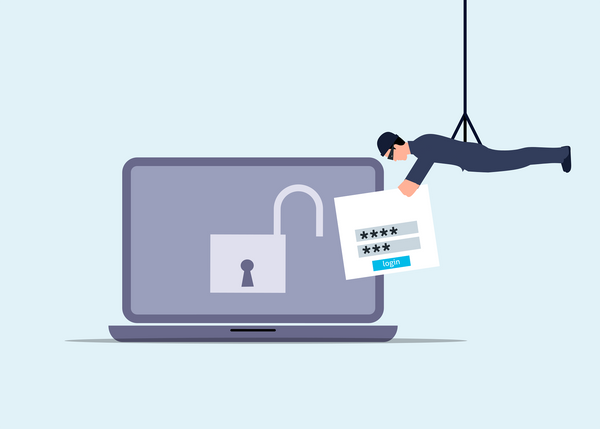Web of Lies: Mastering the Art of Dodging Scam Websites

Nowadays we spend much of our time online. Despite the huge convenience the Internet has brought us in recent decades, we’re still a long way from mastering the art of navigating it safely. Safe browsing requires awareness and vigilance, especially in identifying and avoiding digital hazards.
Scam websites are among the most common threats online. These deceptive hubs of malice are cunningly crafted to lull people into a false sense of security and legitimacy, and ultimately steal their money, personal information, or both.
Our guide delves into scam websites, what they are, how they work, types of scam websites you can encounter in the wild, and how to spot and avoid them effortlessly.
What are Scam Websites?
Scam websites are the digital equivalent of traps, set by cybercriminals to deceive and exploit the unsuspecting. They often replicate the look and feel of legitimate websites to achieve their nefarious goals. Understanding the nature of these malicious sites is one of the most important steps toward protecting yourself.
Types of Scam Websites
The cunning of threat actors knows no bounds, as there are numerous types of scam websites that could entrap you.
Knowing what types of scam websites exist is crucial so you can diversify your attention span and dodge them all with grace.
- Phishing Sites: Phishing websites typically mimic legitimate websites, such as banks or official government sites, to steal login credentials or personal data. They often contain forms asking for sensitive information.
- Fake Stores: Online storefronts that apparently sell products but either don't deliver anything or send counterfeit goods. Most of the time threat actors make away with the money and vanish into the digital ether.
- Investment Scams: Sites promising high returns on investments in cryptocurrencies, stocks, or other financial products. Perpetrators use them to amass large sums of money quickly, then disappear.
- Fake Charities: Websites created to collect donations under the guise of helping a cause; however, scammers just pocket the funds.
- Lottery or Sweepstakes Scams: Promising big prizes in exchange for personal information or a processing fee. Once the scammer takes hold of the money or sensitive data, they vanish without a trace.
How to Spot Scam Websites
Vigilance is your best defense against scam websites. Knowing the tell-tale signs of a rogue site can help you identify and avoid these digital traps before they ensnare you.
- Check the URL Carefully: Look for slight misspellings, extra letters, or incorrect domains (e.g., .net instead of .com).
- Look for HTTPS: While not foolproof, the presence of
https://in the address bar indicates a secure connection. The absence of a secure connection, especially on pages that request personal information, is a red flag. - Poor Design and Grammar: Professional websites typically have high-quality graphics and good grammar. Most scam websites, on the other hand, have glaring grammatical errors and poor-quality images, often stolen from their legitimate counterparts.
- Too-Good-To-Be-True Offers: Extremely low prices or high rewards for little investment are common baits used by scam websites. A sense of urgency and fear of missing out (FOMO) are also common techniques they use to impede critical thinking and urge potential victims to act hastily, without properly assessing the situation.
Understanding Scam Mechanics
Scam websites often employ sophisticated tactics designed to trigger an emotional response and prompt immediate action.
Understanding threat actors’ tactics, techniques and procedures can help you remain calm and analytical in the face of potential scams.
- Urgency and Fear: Perpetrators often create a sense of urgency or invoke fear to push you into making hasty decisions. This could be through warnings about security breaches, claims of legal issues, or alerts that an offer is about to expire.
- Impersonation: Scammers frequently impersonate legitimate entities, such as government agencies, well-known companies, or public figures, to gain your trust and coax sensitive information. With the help of Artificial Intelligence, threat actors can now create convincing deepfake videos portraying celebrities or trusted entities, narrowing the gap between obvious hoaxes and legitimate content.
- Social Proof and Testimonials: Scammers often use fake testimonials and reviews to enhance a site's credibility. These appear to be written by happy customers or renowned institutions, making the scam seem legitimate.
- Phishing Tactics: These include using emails or messages that link to the scam websites. The messages might look like they're from a legitimate source and often ask you to update your information, confirm account details, or address a supposed issue with your account.
Red Flags for Identifying Scam Websites
Some red flags are more obvious than others, but you should pay attention to all of them, as they’re meant to alert you to dangers.
- Generic or Missing Contact Information: Legitimate companies provide detailed contact information. Be wary of generic or absent details.
- Pop-Up Messages: Threat actors often use excessive pop-ups or alerts to create a sense of urgency, or offer too-good-to-be-true promises. Keep a cool head and avoid acting hastily in these situations.
- Request for Personal Information: Be cautious if a site requests lots of personal information upfront, especially payment details.
- Unusual Payment Methods: Requests for payment via wire transfer, prepaid debit cards, or cryptocurrencies are common in scams. If you’re about to make a payment on a website, use traceable payment methods.
How to Avoid Scam Websites
Proactivity is key to avoiding scam websites. Implementing a few practical tips can significantly enhance your internet safety.
- Use Antivirus Software: Install and maintain trustworthy antivirus software such as Bitdefender Ultimate Security. It can deter viruses, Trojans, worms, rootkits, zero-day exploits, spyware, ransomware and other intrusions. It also features advanced anti-scam modules that notify you if you land on a potentially harmful website while blocking all known infected links.
- Educate Yourself and Others: Awareness is your first line of defense. Educate yourself about common scams and share the knowledge with friends and family.
- Verify the Site's Legitimacy: Use tools like Google Safe Browsing (google.com/safebrowsing) to check a website’s safety.
- Use Scam Detection Tools: Services like Bitdefender’s Scamio can help you detect and dodge scammers before they harm you. Scamio can detect fraud attempts from messages, texts, emails, images and QR codes. Additionally, you can describe a sketchy situation and Scamio will assess it instantly, letting you know whether it’s a scam. Scamio is free and available on Facebook Messenger, WhatsApp and your web browser. You can also help others stay safe by sharing Scamio with them in France, Germany, Spain, Italy, Romania, Australia and the UK.
Steps to Take if You've Been Scammed
Even the most cautious individuals can fall prey to scammers. Knowing what to do in this unfortunate situation can help mitigate damage and prevent future occurrences.
- Report the Scam: Contact your bank or credit card provider immediately to report fraud and discuss options such as chargebacks.
- Change Your Passwords: Change passwords for any accounts that may have been compromised.
- Alert Authorities: Report the scam to relevant authorities such as the Internet Crime Complaint Center (IC3) or your country's consumer protection agency.
- Educate Others: Share your experience to help prevent others from falling victim to similar scams.
Conclusion
As cyber threats evolve, so too must our strategies for detecting and defending against them. Understanding the mechanics behind scam websites and identifying their indicators are critical steps in safeguarding personal and financial information.
Users must cultivate skepticism and embrace an analytical mindset toward any online interactions. By remaining informed, taking proactive measures against potential dangers and spreading our knowledge to others we can protect ourselves and contribute to a broader culture of cybersecurity awareness.
Frequently Asked Questions About Scam Websites
- How to check if a website is legit?
If you want to check if a website is legitimate, look for “HTTPS” in the address bar, search for independent reviews and check for comprehensive contact details. Online tools like Google Safe Browsing can help you determine a website’s safety.
- What if you get scammed by a website?
If you get scammed by a website, immediately contact your bank or credit card company to report the fraud and, if possible, reverse charges. Change passwords for all compromised accounts, report the scam to authorities and inform others to prevent the scam from propagating further.
- Can I trust a website?
You can gauge trust in a website by checking for a secure connection (HTTPS), grammar errors, the professionalism of its design and content, and the transparency of its privacy policy and contact information. Always exercise skepticism and thorough verification before proceeding with transactions.
tags
Author

Vlad's love for technology and writing created rich soil for his interest in cybersecurity to sprout into a full-on passion. Before becoming a Security Analyst, he covered tech and security topics.
View all postsRight now Top posts
Your Device ‘Fingerprint’ Will Go to Advertisers Starting February 2025
December 24, 2024
Beware of Scam Emails Seeking Donations for UNICEF or Other Humanitarian Groups
December 19, 2024
Torrents with Pirated TV Shows Used to Push Lumma Stealer Malware
November 14, 2024
FOLLOW US ON SOCIAL MEDIA
You might also like
Bookmarks








